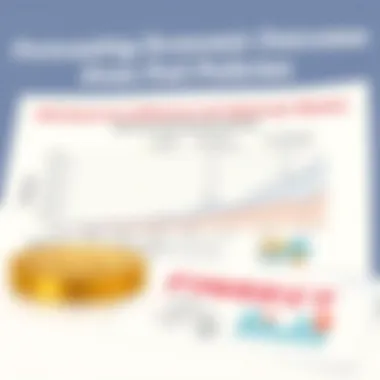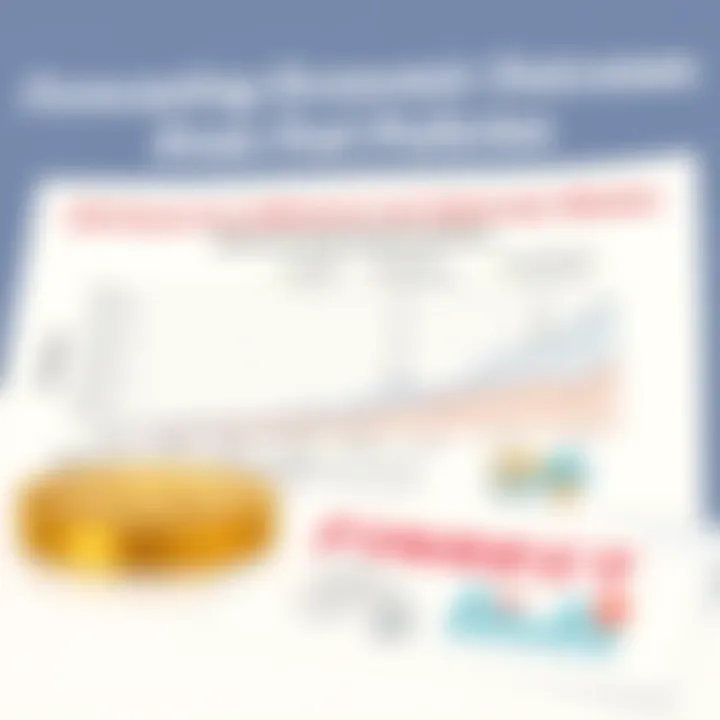Federal Reserve's Influence on Interest Rates Explained


Intro
The Federal Reserve, often referred to as the Fed, plays a pivotal role in shaping the economic landscape of the United States. Its primary function revolves around the adjustment of interest rates, a tool that wields significant power over the economy. With a flick of a pen, the Fed can enhance or suppress economic activity, influencing everything from consumer spending to business investments.
Understanding how and why the Fed alters interest rates is crucial for a variety of stakeholders, including students, investors, advisors, managers, and analysts. Interest rate changes can ripple through the economy like waves spreading from a stone tossed into a pond. When interest rates rise, borrowing becomes more expensive, discouraging spending and investment. Conversely, lower rates can stimulate economic activity, making money more accessible.
In this article, we will dissect the mechanisms through which the Federal Reserve alters interest rates. We will explore the underlying economic principles that dictate these decisions, consider the present economic situation, and analyze the factors that influence the Fed's choices.
Additionally, historical examples will lend context to today’s policies, offering insights that may help forecast future actions. This comprehensive examination aims to clarify the Fed's operations and their broader implications for the economy, providing readers with the knowledge to navigate the complexities of financial markets.
Intro to Interest Rates
Interest rates play a pivotal role in the labyrinth of economic dynamics, acting as a cornerstone for wealth generation, investment, and consumption. The Federal Reserve, as the main player in steering the United States' monetary policy, holds significant power over interest rates, influencing everything from how businesses invest to how consumers shop. This exploration into interest rates is imperative, as it establishes a basis for understanding not just how rates are set but why they matter so much.
Defining Interest Rates
Interest rates essentially refer to the cost of borrowing money, expressed as a percentage of the total amount borrowed, usually over a specific period. This formula is crucial for economic analysis, as it governs the affordability of loans for both individuals and organizations. In simplistic terms, when interest rates soar, borrowing becomes a weighty endeavor. Conversely, when they dive, it encourages spending and investment, allowing economic growth to flourish.
It's also important to distinguish between nominal and real interest rates. Nominal interest rates are the rates as stated, without any adjustments for inflation. Meanwhile, real interest rates consider inflation, providing a clearer picture of the true cost of borrowing. For example, if you have a nominal interest rate of 5% but inflation is at 2%, the real interest rate is just 3%. This distinction is important for anyone deciphering market conditions or planning investments.
The Role of Interest Rates in the Economy
Understanding the influence of interest rates on the broader economy reveals the interconnectedness of various economic elements. For one, interest rates affect consumer behavior significantly. When rates are low, borrowing costs go down, making it easier for people to take out loans. This can pump life into sectors like real estate and automobile sales, as folks feel more confident in their pocketbooks.
Another aspect lies in investment strategies. Investors tend to flock to or pull back from certain assets based on interest rates. When rates are low, businesses may borrow to expand, hire more employees, or invest in research and development. Conversely, higher rates might keep them strapped for cash and thus wary of extending their reach.
Additionally, international implications cannot be overlooked. As the U.S. adjusts its interest rates, currencies ripple through the global markets causing shifts in trade balances and capital flows. Tightening domestic monetary policy could even attract capital inflows, appreciating the dollar and affecting U.S. exports.
Understanding interest rates helps investors and managers foresee economic cycles, positioning themselves well in the marketplace.
So, whether one is a student of economics, an investor, or a manager, grasping the nuances of interest rates offers a compass for navigation through the economic landscape. In essence, this foundational understanding sets the stage for further exploration into how the Federal Reserve influences these crucial rates.
Understanding the Federal Reserve
Understanding the Federal Reserve is pivotal for grasping how interest rate adjustments unfold and what they signify for the broader economy. The Federal Reserve, often simply called "the Fed," is the central bank of the United States, and it plays a crucial role in managing the country's monetary policy. As the entity that oversees and regulates the U.S. money supply, understanding its functions and inner workings illuminates why the Fed's decisions on interest rates can have wide-ranging impacts on everything from individual consumers to national economic health.
By delving deeper into the Federal Reserve, readers can appreciate the nuances behind interest rate decisions. This not only aids in anticipating market movements but also assists investors, policymakers, and the general public in understanding potential changes in borrowing costs and economic growth. A thorough comprehension equips stakeholders to better navigate the complexities of the economy and make informed decisions.
Overview of the Federal Reserve System
The Federal Reserve System established in 1913, acts as the backbone of the U.S. financial system. It maintains stability by regulating banks, managing monetary policy, and providing various financial services. Comprising 12 regional banks and a Board of Governors, the structure of the Federal Reserve is designed to balance diverse regional economic interests while maintaining a cohesive monetary policy.
The regional banks play separate but complementary roles in executing the Fed's policies. For instance, these banks conduct research on local economic conditions, which informs the overall policy-making process. This decentralized nature ensures that the Federal Reserve can respond to the unique economic challenges faced by different areas of the country.
Additionally, the Federal Reserve's mandate often boils down to three core aspects:
- Promoting maximum employment: By adjusting interest rates, the Fed can stimulate job creation or cool down an overheating job market.
- Maintaining stable prices: Keeping inflation under control is crucial. High inflation can erode purchasing power, while deflation may curb spending and investment.
- Regulating and supervising banks: This ensures consumer confidence in the banking system, maintaining liquidity and security for depositors.
By synthesizing these functions, the Federal Reserve effectively serves as a stabilizing force in America’s economy, powered by data-driven research and responsive policy-making.
Monetary Policy Objectives
Monetary policy objectives are at the heart of the Federal Reserve's role, guiding how the central bank steers the economy. These objectives aim to achieve sustainable economic growth while ensuring stability in the financial sector.
Key objectives include:
- Controlling Inflation: The Fed targets an inflation rate of around 2% as a sign of a balanced economy, where prices are stable, yet allow for reasonable growth.
- Maximizing Employment: The relationship between interest rates and employment is significant. Lowering interest rates can spur investments and hiring, thereby increasing job opportunities.
- Stabilizing Financial Markets: The Fed ensures liquidity in the banking system, primarily through its role as a lender of last resort, assisting institutions facing crises and preventing possible bank runs.
A careful balance of these objectives is critical. For example, while raising interest rates could be beneficial in controlling inflation, it might simultaneously lead to slowed economic growth and increased unemployment.
Ultimately, understanding these monetary policy objectives helps clarify the rationale behind the Federal Reserve's actions in adjusting interest rates and how those actions ripple through the economy, impacting consumers and businesses alike.
"The Feds responsiveness to economic indicators reflects its essential role in steering the U.S. economy toward stability and growth."
To expand your understanding further, resources such as the Federal Reserve's own website, federalreserve.gov, and educational platforms like investopedia.com provide an abundance of information on these topics.
Mechanisms of Interest Rate Adjustment
Understanding the mechanisms through which the Federal Reserve adjusts interest rates is vital for grasping how monetary policy impacts the economy. These mechanisms are like the tools in a mechanic's toolbox—each serves a specific purpose and affects different parts of the system. The Fed uses these tools to steer the economy towards stability and growth, navigating challenges like inflation and unemployment.


Tools for Rate Changes: Open Market Operations
Open Market Operations (OMO) is the primary means by which the Federal Reserve influences interest rates. Simply put, it involves the buying and selling of government securities in the open market. When the Fed wants to lower interest rates, it buys securities, which infuses banks with cash. This increase in bank reserves leads to lower borrowing costs, encouraging spending and investment. Conversely, selling securities takes cash out of the banking system, pushing up interest rates. In this way, OMO shapes the liquidity available in the economy, directly affecting how much it costs to borrow money.
"The efficacy of Open Market Operations is not just in the immediate liquidity effect; it's in setting the prevailing mood in markets about future rate moves."
The Discount Rate and Its Implications
The discount rate is another crucial tool. It’s the interest rate charged to commercial banks for short-term loans from the Federal Reserve. When the Fed lowers the discount rate, it effectively encourages banks to borrow more. This can lead to an increase in overall lending and spending in the economy since banks feel more secure in lending to businesses and consumers. However, raising the discount rate can signal a tightening monetary stance, which might cool off spending and investment. The implications of adjusting this rate ripple through the financial system, influencing everything from consumer loan rates to mortgage rates. Understanding these dynamics is crucial for various economic players.
The Federal Funds Rate: A Crucial Benchmark
The Federal Funds Rate is the interest rate at which banks lend to one another overnight. This rate is of paramount importance because it serves as the benchmark for most other interest rates in the economy. Changes to the Federal Funds Rate can have broad ramifications, affecting everything from credit cards to mortgage rates. When the Fed alters this rate, it signifies its view of the economic landscape and its approach to managing inflation and growth. A lower rate usually indicates an effort to boost economic activity, whereas a higher rate aims to cool off overheating in the economy. Investors, businesses, and consumers alike closely watch these announcements since they can substantially affect financial decisions and strategies.
In summary, the mechanisms of interest rate adjustment are complex yet essential for understanding the wider economic context. From Open Market Operations to the Federal Funds Rate, each tool plays a significant role in shaping monetary policy and, ultimately, the nation’s economic health.
Factors Affecting Interest Rate Decisions
Understanding what drives decisions on interest rate adjustments is fundamental when analyzing the approach of the Federal Reserve. These factors shape not just the immediate economic landscape but reverberate across various sectors, influencing everything from consumer behavior to complex investment strategies. Let’s break down some of the key elements that come into play when the Fed contemplates changing the interest rates.
Inflationary Pressures
Inflation stands as a formidable force in the field of economics. When prices rise persistently, the purchasing power of consumers shrinks, causing various economic ripples. The Federal Reserve closely monitors inflation rates, often gauged by the Consumer Price Index (CPI) or the Personal Consumption Expenditures (PCE) index. These metrics tell the Fed whether higher or lower interest rates are needed to align the economy with its inflation targets.
When inflation exceeds the Fed's comfort zone, which typically hovers around 2%, adjustments in interest rates become almost inevitable. The rationale is simple: raising interest rates can cool down spending and borrowing activities, effectively tempering inflationary pressures. However, this dance isn’t without its risks. Set the bar too high too quickly, and you risk stalling economic growth entirely.
"Interest rates are not just numbers; they are indicators of broader economic health."
Employment Data Insights
Employment statistics provide crucial insight into the economy’s vitality. The Federal Reserve often turns to the unemployment rate and labor force participation rate as bellwethers for economic strength. Low unemployment rates typically suggest a robust economy where consumers have disposable income to spend. Yet, the Fed needs to tread carefully; if the labor market heats up too much, wage growth may escalate, leading to inflation.
In assessing employment data, the Fed also looks into job creation rates and sector-specific growth. For instance, if the tech industry is booming while manufacturing lags, the Fed may decide that overall wage growth will be uneven, potentially justifying caution in rate adjustments.
- Indicators to watch:
- Unemployment Rate
- Job Creation Numbers
- Labor Force Participation Rate
Understanding these nuances allows the Fed to forecast how interest rates may need to react. Keeping an ear to the ground on job market fluctuations is not just an economic formality; it's a pivotal lifeline for making informed, timely decisions.
Global Economic Considerations
In an interconnected world, domestic monetary policy cannot be viewed in isolation. External economic conditions profoundly influence the Federal Reserve's decision-making process. Economic slowdowns in major economies can impact U.S. exports, while political instability abroad can cause market fluctuations. This global context can't be overlooked.
The Fed’s perspective is also shaped by international trade relationships, currency values, and geopolitical events. For example, an emerging market crisis could potentially reduce demand for U.S. goods, prompting the Fed to lower interest rates to stimulate domestic consumption. Alternatively, if a foreign economy is seeing explosive growth, it might lead to an increase in demand for U.S. exports, allowing the Fed to maintain or raise rates without compromising economic growth.
- Key global indicators to consider:
- Exchange Rate Stability
- Economic Growth in Major Trading Partners
- Global Commodity Prices
Ultimately, these global variables remind us that the Federal Reserve operates in a complex web of economic interdependencies. Adjusting interest rates isn’t merely a local affair; it’s a strategic maneuver that involves reading the tea leaves of the global market.
As we decipher the various factors influencing interest rate decisions, it becomes apparent that the balancing act undertaken by the Federal Reserve is intricate and filled with implications. Understanding these dynamics is essential for stakeholders wishing to navigate the economic waters successfully.
Historical Context of Interest Rate Changes
Understanding the historical context of interest rate changes is paramount in grasping the Federal Reserve's decision-making mechanisms. Without it, one might view the Fed's actions as isolated events rather than part of a broader economic narrative. Analyzing past interventions provides valuable insights into their effectiveness, timing, and repercussions. By studying previous rate changes, analysts and policymakers can better anticipate future moves and their potential impacts on the economy.
Previous Rate Hikes and Economic Impact
Looking back at rate hikes reveals a complex tapestry of economic outcomes. For instance, during the late 1970s and early 1980s, the Federal Reserve, led by Paul Volcker, dramatically increased interest rates to combat rampant inflation. The federal funds rate peaked at over 20%. While this tougher stance ultimately tamed inflation, it also initiated a significant recession in the early 1980s, leading to spikes in unemployment and a contraction of the economy. This is a classic example that underscores the dual-edged sword nature of aggressive rate hikes.
- The stickiness of inflation in 1979 forced Volcker's hand to adopt a strategy that many in the public initially viewed with skepticism.
- The recession, however, served as a long-term corrective measure, lowering inflation in the subsequent decades and laying down a path for stable growth.
Critiques of this approach often point to the short-term pain inflicted on millions of Americans who lost jobs or homes during the recession. These historical case studies signal that while increasing interest rates can stabilize or correct an overheating economy, the human cost can be significant and requires thoughtful consideration.
Lessons from the Financial Crisis
The financial crisis of 2007-2008 brought the Federal Reserve’s capacity to change rates into sharp focus. Not only did it expose vulnerabilities in financial institutions, it also prompted an unprecedented response from the Fed. Decreasing the federal funds rate to nearly zero was an attempt to stimulate borrowing and investment during a time of dire economic straits. The situation highlighted several crucial lessons:
- Speed of Action: The Fed learned the importance of swift action. The longer it took to respond to rising economic distress, the more severe the consequences became.
- Communication is Key: The Fed's leadership recognized that effective communication with the public and investors was essential to maintain confidence during turbulent times. Clear messaging helped to guide market expectations around potential rate changes.
- Quantitative Easing: Resorting to unconventional tools, like quantitative easing, became a legacy strategy in response to the crisis. The Fed's purchase of large quantities of government securities showcased a flexible approach in altering monetary policy, further emphasizing that traditional rate adjustments might not always suffice.


This period ensured that both the Fed and the broader economy could no longer rely solely on interest rate changes as a remedy. Instead, it underscored the necessity for a multi-faceted approach to monetary policy, incorporating various tools and strategies to navigate complex economic landscapes.
"The past is not dead. In fact, it’s not even past." - William Faulkner
By examining historical context, the electorate, economists, and policymakers can navigate forward with enhanced awareness. The Fed's historical decisions have shaped the landscape that current policymakers operate within, reminding us that tomorrow's policies are often dictated by yesterday's realities. For further reading on the topic, consider resources on economic history at en.wikipedia.org or analyses from the Federal Reserve's official site.
Current Economic Landscape
The current economic landscape plays a pivotal role in shaping the Federal Reserve's actions regarding interest rates. As the front line between monetary policy and the broader economy, various elements within today's economic setting are closely watched by analysts, policymakers, and investors alike. Understanding these factors can illuminate the reasons behind potential interest rate adjustments, thus enabling better forecasting and strategic planning.
Assessment of Current Economic Indicators
To comprehend the Fed's approach to interest rates, one must first assess the major economic indicators that reflect the health of the economy. These are like the vital signs of economic activity:
- Gross Domestic Product (GDP): A growing GDP usually hints at a flourishing economy. A rise in GDP might prompt the Fed to consider increasing interest rates to prevent overheating, while a decline might have the opposite effect.
- Employment Figures: The unemployment rate serves as a gauge of economic vitality. A lower rate often signals robust economic activity, leading the Fed to potentially raise interest rates to stave off inflation. Conversely, higher unemployment can trigger rate cuts to stimulate growth.
- Inflation Rate: Central to the Fed's mandate, inflation impacts purchasing power. When inflation runs too high, the central bank may increase rates to cool it down. This balancing act is crucial to maintaining economic stability and fostering sustainable growth.
- Consumer Price Index (CPI): Often cited alongside inflation, CPI tracks changes in prices paid by consumers. A rising CPI may indicate inflationary pressures which compel the Fed to rethink their current interest rate policies.
"Economic indicators are much like a compass; they guide the Federal Reserve through the sometimes murky waters of economic conditions."
In analyzing these indicators, the Fed has to navigate a complex tapestry of data, each thread revealing different aspects of economic health. They must adapt their strategies accordingly, considering the subtle nuances that each economic figure presents.
Consumer Confidence and Spending Trends
Consumer confidence plays an impressive role in economic dynamics. When consumers feel optimistic about their financial prospects and the overall economy, they are more inclined to spend. This spending fuels consumer-driven markets, pushing businesses to ramp up production and hiring, ultimately influencing the Fed's decision-making process regarding interest rates.
- Trends to Monitor: Consumer confidence surveys like The Conference Board's Consumer Confidence Index (CCI) provide insights into the public sentiment regarding personal finances and overall economic outlook. A significant dip in consumer confidence may raise red flags, prompting the Fed to adopt a more accommodative monetary stance to invigorate spending.
- Impact of Interest Rates on Consumer Behavior: When the Fed raises interest rates, borrowing costs increase, leading to a natural slowdown in consumer spending. Conversely, lowering rates often encourages consumers to take loans for big-ticket items like homes and cars, fostering economic growth.
Potential Outcomes of Raising Interest Rates
The topic of raising interest rates is not just a number on a page; it breathes life into the complex dance of the economy. When the Federal Reserve opts to alter interest rates, the ramifications can stack up like dominoes, triggering independent but interconnected changes across various sectors. Understanding these potential outcomes is crucial as they not only define the immediate impacts but also shape future economic landscapes.
Impact on Borrowing Costs
When interest rates rise, borrowing costs tend to follow suit. This increase can influence everything from personal loans to corporate financing strategies. For individuals, a higher rate means that loans for homes or cars become more expensive. For instance, if you plan to buy a home and the interest rate on mortgages increases, that means higher monthly payments, potentially squeezing your budget. Similarly, small businesses might find themselves reluctant to take loans for expansion or new equipment due to the increased costs associated with higher rates.
- Examples of Borrowing Cost Increase:
- Mortgage rates rise from 3% to 4%.
- Business loans become pricier, leading to stunted growth or innovation.
This adjustment may also bring a cooling effect on consumer confidence. When people perceive borrowing as costly, they might cut back on spending, leading to slower economic growth.
Effects on Investment Strategies
Raising interest rates sends ripples through the investment landscape. Generally, when rates climb, traditional fixed-income investments, like bonds, may become more appealing than stocks. Investors might start rebalancing their portfolios as they weigh the risks and potential returns. For instance, a conservative investor could pivot from stocks to bonds, sensing a more reliable and safer path with the returns projected from fixed-income securities.
- Considerations for Investment Shifts:
- Stocks may experience downward pressure as valuations adjust to higher rates.
- Real estate investments could fluctuate, sticking to traditional patterns or tilting toward rental income as buyers retreat.
"Investment strategies often mirror the tides of interest rates. One must always be ready to navigate changes and adjust accordingly."
As a result, sectors like technology or consumer discretionary that generally thrive in low-rate environments might encounter headwinds, while utilities or financials could enjoy tailwinds as investors seek stability and income.
Consumer Behavior Adjustments
Raising interest rates inevitably alters how consumers behave. With borrowing becoming more expensive, consumers may tighten their belts. Daily spending habits could shift, with discretionary spending often the first place consumers seek to economize. A family might put off a vacation or delay buying that new car. This retraction in consumer spending can lead to a cascading effect on businesses dependent on robust consumer purchases.
- Examples of Changes in Consumer Behavior:
- Families avoid impulse purchases, leading to reduced retail sales.
- Investors might defer large purchases, impacting overall economic sentiment.
Changes in consumer behavior not only influence individual businesses but can also have a broadanging impact on the economy as a whole. When fewer people are buying, businesses react, potentially affecting hiring decisions or leading to layoffs. Understanding these adjustments forms a critical part of the narrative surrounding changes in interest rates, showcasing just how intertwined these elements are within the broader economic framework.
Arguments for and Against Rate Increases
The discussion surrounding interest rates and the Federal Reserve's decisions to modify them is both intricate and significant. Understanding the arguments for and against rate hikes provides valuable insight into the broader economic implications of such moves. The balances between fostering economic growth and keeping inflation in check are at the heart of these deliberations, making it a pivotal topic for anyone engaged in economic studies or financial markets.
Economic Growth vs. Inflation Management
When the Fed considers raising interest rates, a central concern isn't merely about poking the economy with a stick. Rather, it’s like walking a tightrope: one side represents economic growth, while the other represents the weight of inflation. Low interest rates generally fuel borrowing and spending. This can lead to increased investments by businesses and consumers, thus nurturing economic expansion.
However, there comes a point where the economic engine might start overheating. This is where inflation management steps in. A rise in prices can spiral faster than a kid on a sugar rush if left unchecked, impacting the purchasing power of the dollar. Essentially, if the Fed raises rates, it can help cool off an overheating economy, taking the wheels off rapid price increases and stabilizing the dollar's value.


For instance, during the late 1970s, inflation rates reached alarming highs, compelling the Fed under Paul Volcker to implement aggressive rate hikes. This choice, while effective in combating inflation, also led to a recession that held off growth for several years. Therefore, the deliberation is whether to prioritize immediate economic growth or to enforce a steady control over inflation in the long run.
"The delicate balance between fostering growth and curbing inflation makes the Fed’s role increasingly nuanced in a dynamic economy."
Short-term vs. Long-term Effects
Examining the implications of alterations in interest rates isn’t a surface-level venture; it’s crucial to consider both short-term and long-term effects. In the short run, higher interest rates can pinch consumer spending and slow down business investments. Picture a family holding off on buying a new car because their monthly payments are going to be heftier, or a start-up changing its plans since loans became more expensive. These adjustments can cool down immediate economic activity.
Long-term effects tell a different story, though. Higher rates can, paradoxically, lead to more sustainable growth. By reducing the excesses driven by cheap credit, companies might innovate more responsibly, leading to healthier economic cycles over time. A disciplined approach to borrowing ensures that businesses focus on genuine growth rather than chasing short-term profits through easy loans.
Despite the short-term constraints, education and adjustment are key. The Fed’s messaging and guidance can help set expectations, allowing businesses and consumers to adapt. A well-communicated strategy can temper the immediate shocks felt from a rate increase, fostering a more stable long-term environment.
In summary, any action taken by the Federal Reserve regarding interest rates presents both opportunities and challenges. Stakeholders, including students, investors, advisors, managers, and analysts, must grasp this duality to navigate an increasingly complex economic landscape. Whether emphasizing growth or focusing on managing inflation, it remains a delicate balance that shapes the economic future.
The Fed's Communications Strategy
The Federal Reserve's approach to communication is a cornerstone of its monetary policy effectiveness. The manner in which the Fed conveys information about interest rate changes can significantly influence market expectations and overall economic behavior. Understanding this aspect is crucial for anyone wanting to grasp how the Fed operates and impacts the financial landscape.
Through its communications strategy, the Fed aims to provide clarity and predictability to financial markets, aiming for a smoother path for policy adjustments. This strategy isn't just about sending out press releases; it encompasses a variety of tools and formats designed to manage the expectations of investors, consumers, and other stakeholders.
Expectations Management
Expectations management entails the Fed's efforts to align public perception with its policy objectives. In practical terms, this means that when the Fed hints at possible rate changes through speeches or policy statements, it’s doing more than just disseminating information—it’s actively shaping how the market interprets and reacts to that information.
For example, when Fed Chair Jerome Powell discusses economic conditions in a careful, measured tone, markets may interpret this as a sign that the Fed is likely to raise interest rates sooner rather than later. Not only does this strategy help guide investor behavior, but it also reduces volatility in financial markets. By doing this, the Fed can potentially prevent panic reactions that could lead to economic disruptions.
In addition to using language that is transparent and accessible, the Fed also considers the timing and medium of its communications. For instance, quarterly reports often coincide with broader economic data releases, ensuring stakeholders have the most relevant information at their disposal when interpreting the Fed's stance. This calculated approach is designed to assuage fears of unexpected rate hikes or cuts, facilitating a more stable economic environment.
Market Reactions to Fed Announcements
The markets have a keen sense of the narrative that surrounds the Fed’s announcements. Traders and investors closely analyze each word, tone, and inflection in Fed communications, as they can have immediate consequences on stock prices, bond yields, and even foreign exchange rates.
When the Fed announces a change in the interest rate or gives signals about future adjustments, market reactions can be swift, often functioning like an instant feedback loop.
- Rate Hikes: A signal that rates are going up often leads to a sell-off in bonds and stocks as investors quickly re-evaluate their portfolios.
- Rate Cuts: Conversely, indications of a potential rate cut can lead to a surge in equities; investors may seek to take advantage of cheaper borrowing costs or prospect improved earnings in a lower interest environment.
The immediate aftermath of a Fed announcement often sees market indicators fluctuating intensely as the implications sink in. Traders might express their optimism or pessimism through various instruments, making it clear that the Fed's communications hold considerable sway over market sentiment.
In summary, the Fed's communications strategy is not merely a backdrop to its actions but rather an active mechanism that shapes economic expectations and market behavior. It serves as a bridge between the Fed's policy intentions and the responses from various economic actors, demonstrating the importance of effective communication in maintaining economic stability.
Future Considerations for Interest Rates
The future of interest rates is a topic that holds significant importance for a wide variety of economic actors ranging from students to seasoned investors. Understanding how shifts in policy could trigger changes in the rate environment can help inform decisions, strategies, and long-term planning. The Federal Reserve's actions set off ripples that can influence everything from mortgage rates to the availability of credit. Therefore, keeping an eye on potential future scenarios is crucial for any stakeholder in the economic landscape.
Possible Scenarios Based on Economic Trends
As we peer into the crystal ball of financial forecasting, it becomes evident that multiple scenarios may unfold based on the prevailing economic landscape. Consider the following:
- Moderate Economic Recovery: Should the economy continue to recover post-recession, the Federal Reserve might incrementally increase interest rates to stave off inflation. This gradual approach could encourage sustainable growth, allowing businesses and consumers to adjust accordingly.
- Stagnation or Recession: In a less favorable scenario where the economy stagnates or enters recession, the Fed may opt to lower rates further, possibly into negative territory. This could spark borrowing but might also weaken confidence in the dollar.
- Unexpected Inflation Spike: If inflation unexpectedly surges due to supply chain disruptions or other external pressures, the Fed could be caught in a bind, needing to hike rates sharply to contain inflation without stalling economic growth.
Understanding these scenarios provides a framework for businesses and individuals to align their economic strategies and prepare for potential shifts in the financial landscape.
Long-term Structural Changes in the Economy
The economy is not a static entity; it evolves with structural changes that can reshape the interest rate environment.
One such change is the increasing digitization of finance, which could lead to new forms of monetary policy not yet fully understood. The rise of cryptocurrencies and digital currencies issued by central banks may significantly impact traditional interest rate mechanisms. Businesses and investors need to factor these developments into their long-term strategies.
Another area to consider is the globalization of markets. As different economies become more interconnected, the decisions made by the Federal Reserve will resonate past borders, influencing foreign investments and currency valuations. Changes in policies in other countries, such as the actions taken by the European Central Bank or the Bank of Japan, will provide context for the Fed's decisions.
The End: The Path Ahead
While the Federal Reserve's ability to adjust interest rates plays a crucial role in steering the economy, the path ahead is fraught with complexities and challenges. The decisions made by the Fed not only influence monetary policy but also weave themselves into the fabric of everyday life, affecting everything from mortgages to savings accounts. Hence, a deep understanding of these impending changes is beneficial for various stakeholders.
Summarizing Key Insights
The intricate relationship between the Federal Reserve's interest rate decisions and the economic landscape cannot be overstated. Key insights from this discussion include:
- Monetary Policy Tools: The Fed employs specific tools, such as open market operations and the discount rate, to influence interest rates and, subsequently, economic activity.
- Indicators of Change: Inflation rates, employment statistics, and global economic impacts are critical factors in the Fed's decision-making process; these elements shape the likelihood of rate adjustments.
- Historical Context: Understanding past economic cycles—especially during times of crisis—provides valuable lessons on the effectiveness and timing of rate changes.
- Market Reactions: Anticipation of the Fed's actions can sway market behavior, as investors often react to the signals sent through press releases and public statements.
"A key takeaway is that the Fed's decisions are not made in a vacuum; they ripple through various sectors, impacting a wide array of economic activities."
As we move forward, recognizing these factors sharpens the perspective of students, investors, and economists alike, allowing them to better navigate the future economic terrain.
Final Thoughts on Rate Adjustments
The implications of interest rate adjustments are profound. They touch on fundamental economic principles: the cost of borrowing and saving, and how individuals and businesses make financial choices. Given today’s fluctuating markets, the Fed’s policy decisions promise to be more significant than ever.







